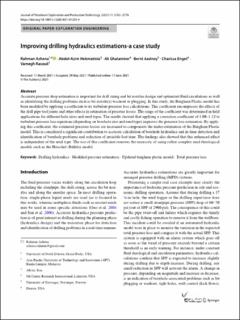| dc.contributor.author | Ashena, Rahman | |
| dc.contributor.author | Hekmatinia, Abdol-Azim | |
| dc.contributor.author | Galambor, Ali | |
| dc.contributor.author | Aadnøy, Bernt Sigve | |
| dc.contributor.author | Enget, Charissa | |
| dc.contributor.author | Rasouli, Vamegh | |
| dc.date.accessioned | 2022-02-22T08:58:37Z | |
| dc.date.available | 2022-02-22T08:58:37Z | |
| dc.date.created | 2022-01-27T08:48:05Z | |
| dc.date.issued | 2021-06 | |
| dc.identifier.citation | Ashena, R., Hekmatinia, A-A., Galambor, A., Aadnøy, B.S., Enget, C., Rasouli, V. (2021) Journal of Petroleum Exploration and Production Technology, 11, 2763-2776. | en_US |
| dc.identifier.issn | 2190-0558 | |
| dc.identifier.uri | https://hdl.handle.net/11250/2980699 | |
| dc.description.abstract | Accurate pressure drop estimation is important for drill string and bit nozzles design and optimized fluid circulations as well as identifying the drilling problems such as bit nozzle(s) washout or plugging. In this study, the Bingham Plastic model has been modified by applying a coefficient to its turbulent pressure loss calculations. This coefficient encompasses the effects of the drill pipe tool joints and other effects in estimation of pressure losses. The range of the coefficient was determined in field applications for different hole sizes and mud types. The results showed that applying a correction coefficient of 1.08–1.12 to turbulent pressure loss equations (depending on borehole size and mud type) improves the pressure loss estimation. By applying this coefficient, the estimated pressure losses are increased to compensate the under-estimation of the Bingham Plastic model. This is considered a significant contribution to accurate calculation of borehole hydraulics and in-time detection and identification of borehole problems and reduction of invisible lost time. The findings also showed that this enhanced effect is independent of the mud type. The use of this coefficient removes the necessity of using rather complex mud rheological models such as the Herschel–Bulkley model. | en_US |
| dc.language.iso | eng | en_US |
| dc.publisher | Springer Nature Switzerland AG | en_US |
| dc.rights | Navngivelse 4.0 Internasjonal | * |
| dc.rights.uri | http://creativecommons.org/licenses/by/4.0/deed.no | * |
| dc.subject | boring | en_US |
| dc.subject | petroleumsteknologi | en_US |
| dc.title | Improving drilling hydraulics estimations ‑ a case study | en_US |
| dc.type | Peer reviewed | en_US |
| dc.type | Journal article | en_US |
| dc.description.version | publishedVersion | en_US |
| dc.rights.holder | © The Author(s) 2021 | en_US |
| dc.subject.nsi | VDP::Teknologi: 500::Berg‑ og petroleumsfag: 510::Petroleumsteknologi: 512 | en_US |
| dc.source.pagenumber | 2763-2776 | en_US |
| dc.source.volume | 11 | en_US |
| dc.source.journal | Journal of Petroleum Exploration and Production Technology | en_US |
| dc.identifier.doi | 10.1007/s13202-021-01203-4 | |
| dc.identifier.cristin | 1990931 | |
| cristin.ispublished | true | |
| cristin.fulltext | original | |
| cristin.qualitycode | 1 | |

